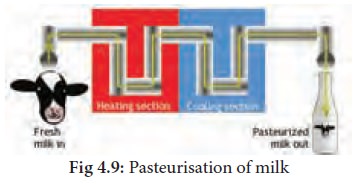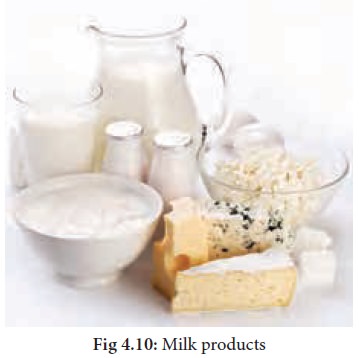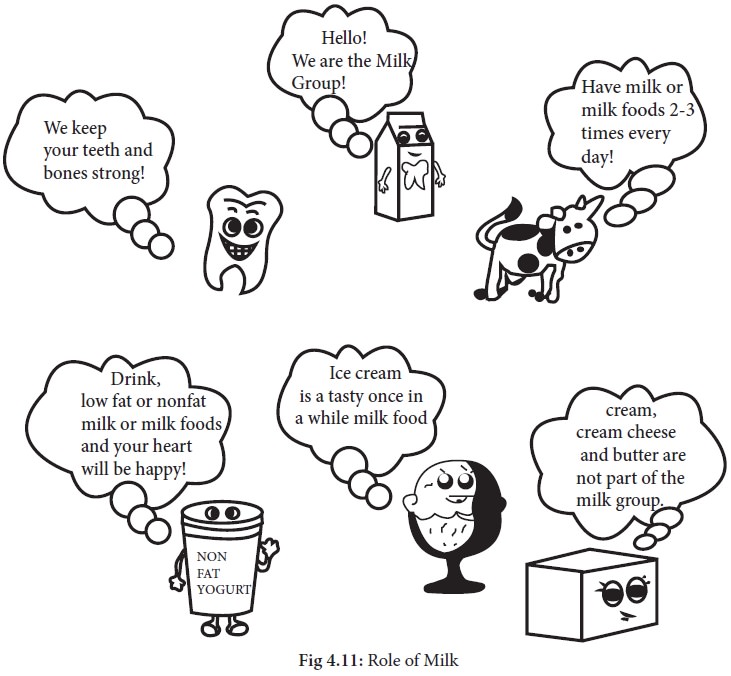Nutritive value, Types, Pasteurisation, Role in cookery - Milk and Milk Products | 11th Nutrition and Dietetics : Chapter 4 : Flesh Foods, Milk and Milk Products
Chapter: 11th Nutrition and Dietetics : Chapter 4 : Flesh Foods, Milk and Milk Products
Milk and Milk Products
Milk And Milk Products
The story of milk goes back to the beginning of civilization itself. Cattle were domesticated even in prehistoric times and milk was one of the most essential of all foods. Milk is one of the most complete single foods available in nature for health and promotion of growth.
Milk is the normal secretion of mammary gland of mammals. Its purpose in nature is to provide good nourishment to the young of the species producing it. Man has learnt the art of using milk and milk products as a food for his well being and has increased the milk producing function of the animals best adapted as a source of milk for him. The cow is the principle source of milk for human consumption in many parts of the world; Other animals as a source of milk for human beings are the buffalo, goat, sheep, camel and mare. In India, more milk is obtained from the buffalo than the cow. Some amount of goat milk is also consumed.
Nutritive value of milk
Milk is a complex fluid containing protein, fat, carbohydrates, vitamins and minerals. The main protein in milk is casein and it constitutes 3.0-3.5 percent of milk. The fat content of milk varies from 3.5 percent in cow’s milk to about 8.0 percent in buffalo’s milk. Fat is present in the form of fine globules varying in diameter from 1

Lactose is the sugar present in milk. The important minerals in milk are calcium, phosphorus, sodium and potassium. Milk is an excellent source of riboflavin and a good source of Vitamin A. However, milk is a poor source of iron and ascorbic acid. The small amount of iron present is bio available.
Types of processed milk
Raw milk is processed into the following types of milk.
1. Skim Milk
Skim milk is whole milk from which fat removed by a cream separator. The quantity of fat is usually 0.05 to 0.1 percent. It contains all other milk nutrients, except Vitamin A and D but can be fortified by the addition of these vitamins.
2. Toned Milk
Toned milk is prepared by using milk reconstituted from skim milk powder. Skimmed milk is prepared by removing fat from milk in a cream separator. Skimmed milk is then mechanically dried to give skim milk powder. It is mixed with buffalo milk containing 7 percent fat. The fat content of toned milk should around 3 percent.
3. Standardised Milk
In standardised milk, the fat content is maintained at 4.5 percent and solids non -fat
4. Homogenised Milk
Homogenisation is a mechanical process that reduces the size of fat globules by forcing milk through small apertures under pressure and velocity. When milk is homogenised, the average size of the globule will be 2 micrometers. The decrease in the size of fat globules increases their numbers and surface area. The newly formed fat droplets brings about stabilization of the milk emulsion and thus prevents rising of the cream. Homogenised milk has a creamier texture, bland flavour and whiter appearance.
5. Evaporated Milk
It is made by evaporating more than half the water from milk under vacuum, at a temperature of 74°C- 77°C. It is then fortified with vitamin D, homogenized and filled into cans.
Pasteurisation of milk
Milk is a favourable medium for bacterial growth. Pasteurisation destroys all pathogenic bacteria, including those causing typhoid, tuberculosis, diphtheria as well as yeasts and moulds. Pasteurization is a process which consists of heating milk to a certain temperature for a definite time to ensure destruction of harmful bacteria. There are three methods of pasteurisation.

a. Holding method or Batch process : In this method, milk is held at 62.8°C for 30 minutes.
b. Hightemperatureshorttimemethod or continuous process (HTST): Milk is heated to 71.7°C for not less than 15 seconds.
c. Ultra High temperature method : Milk is heated to a temperature of 93.4°C for 3 seconds.
In above mentioned methods, after heat treatment, milk should be then rapidly cooled to prevent multiplication of surviving bacteria. During pasteurization the nutritive value of milk is not altered. It does not produce an unpleasant cooked flavour. Harmful pathogens especially TB bacteria are destroyed. Shelf life of milk is increased due to a marked decrease in the total bacterial count.
Milk products
Khoa
Khoa is prepared by
evaporating whole milk in an open cast iron pan with continuous stirring until
it is semi-solid. It is used extensively in the preparation of Indian sweets.
Cream
Cream is the fat of
milk and is used in the preparation of sweets. It is made by simmering large
quantities of milk until a thick layer of milk fat and coagulated protein form
on the surface. It can be consumed with or without the addition of sugar.

Butter
Butter is obtained
from cream by churning. When cream is churned, the fat globules are
destabilised and coalesce until the milk separates into two phases– viz., the
butter and the aqueous phase. Butter is removed and washed.
Butter is used as a
cooking medium in many Indian recipes. It is one of the main ingredients in
cakes, biscuits, icing and bread.
Ghee
Ghee is butter oil. It
is prepared by melting butter and separating the moisture from butter by
heating. It is used in preparing Indian sweets, savouries, curries and variety
rice like pulav and biriyani.
Paneer
Paneer is a soft cheese prepared by addition of lemon juice or citric acid to hot milk and precipitating the casein. The liquid released in this process is known as whey and the resultant curd is tied in a muslin cloth and hung for a day to squeeze any liquid present in it. The soft cheese (paneer) that is obtained is used in Indian gravies and pulavs. It is a very good source of protein
Cheese
It involves the
curdling of milk with enzyme rennet under microbially controlled conditions.
Milk is held at about 27°C in vats and a lactic acid culture is added. When the
milk gets acidic, rennet is added to it and the milk is allowed to coagulate.
The curd formed is cut and heated to about 37°C with constant stirring to
remove the whey. Whey is drained. Salt is mixed with the curd and it is pressed
to remove further amount of whey. The cheese formed is coated with paraffin to
prevent loss of moisture. The paraffined cheese is allowed to ripen for three
to six months at temperatures between 45°to 60°C.Cheese is a concentrated
source of protein.
Curd
Curd is prepared by heating milk to about 50°C. A teaspoon of curd (starter) from an earlier batch of curd is added and is mixed thoroughly. The lactic acid bacteria present in the starter curdles the milk. The bacteria breaks down lactose to lactic acid thereby increasing the acidity of milk. When the pH reaches 4.6, the milk protein casein coagulates as curd. The optimum temperature for the formation of curd is 35 - 40°C and the time needed for curd formation is 8–12 hours depending on the atmospheric temperature. Curd is used as a dressing on salads made from fresh vegetables and combines well with plain cooked rice.
Yoghurt
This is a coagulated
milk product with curd like consistency. It is made from partially skimmed or
whole milk and it has a slightly acidic flavour. In the production of yoghurt,
a mixed culture of Lactobacillus bulgaricus, Streptococcus thermophilus and
Lactobacillus acidophilus is added to pasteurised milk and incubated at 42°C to
46°C.

Role of milk and milk products in cookery
1. It contributes to the nutritive
value of the diet, eg. milkshakes, plain milk, flavoured milk, cheese toast.
2. Milk adds taste and flavour to
the product eg. payasam,tea, coffee.
3. It acts as a thickening agent
along with starch eg. whitesauce or cream soups.
4. Milk is also used in desserts,
eg. icecream, puddings
5. Curd or buttermilk is used as a
leavening agent and to improve texture, eg. dhokla.
6. Curd is used as a marinating
agent, eg. marinating chicken and meat.
7. Curd is used as a souring agent,
eg. ravadosa, dry curdchillies.
8. Khoa is used as a binding agent,
eg. carrot halwa.
9. Cheese is used as garnishing
agent.
10. Salted butter milk is used for
quenching thirst.
Related Topics